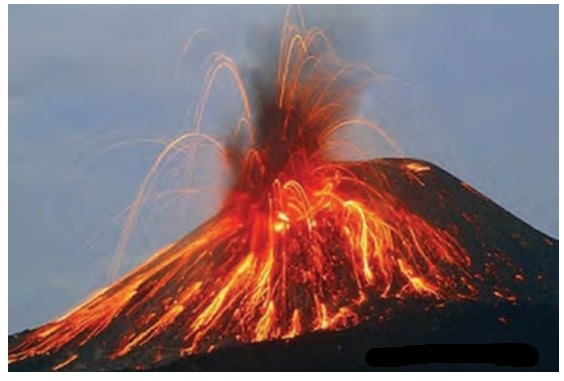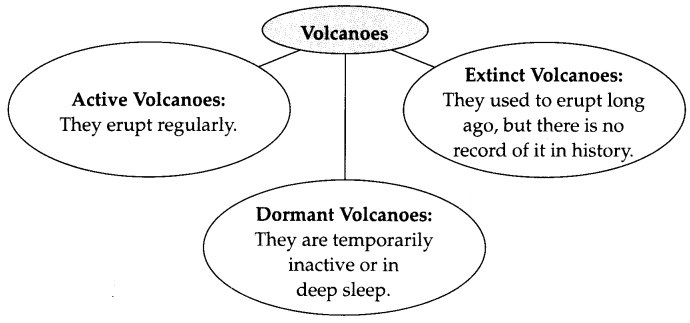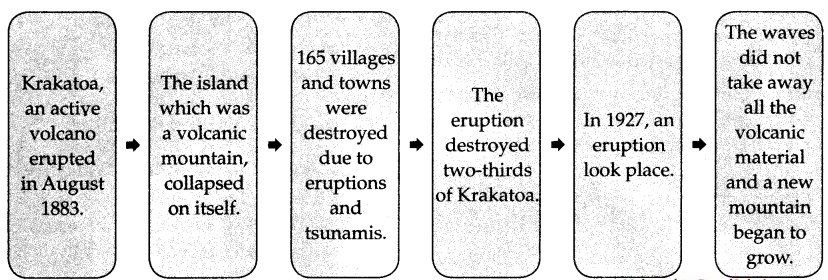Chapter 2.4 Anak Krakatoa
Textbook Questions and Answers
1. Draw a diagram to show a volcanic eruption from its description given in this passage. Label the diagram. Show the following in it: Volcano; earth’s crust; crack in the earth’s crust; hot molten rock; red, hot lava; smoke; ash; burning chunks of rock.
Question 1.
Draw a diagram to show a volcanic eruption from its description given in this passage. Label the diagram. Show the following in it: Volcano; earth’s crust; crack in the earth’s crust; hot molten rock; red, hot lava; smoke; ash; burning chunks of rock.
Answer:

2. Show the three categories of volcanoes using the following tree diagram structure.

Write a very short description of each category below the box.
Question 1.
Show the three categories of volcanoes using the following tree diagram structure.

Write a very short description of each category below the box.
Answer:

3. Show the stages in the process in which Krakatoa collapsed and then Anak Krakatoa formed in the course of volcanic eruptions. Use the flowchart given below.

Question 1.
Show the stages in the process in which Krakatoa collapsed and then Anak Krakatoa formed in the course of volcanic eruptions. Use the flowchart given below.

Answer:

4. Draw a diagram to show how life returned to the island. Label the diagram.
(Use the technique of drawing diagrams when you study science, geography, etc.)
Question 1.
Draw a diagram to show how life returned to the island. Label the diagram.
(Use the technique of drawing diagrams when you study science, geography, etc.)
5. Write short notes on the following:
Question 1.
The 1883 eruption
Answer:
The August 1883 eruption that took place was the worst of the eruptions that took place. The sound of the volcanic eruption was heard more than 3500 kms away in Australia. The island which was a volcanic mountain, collapsed on itself. The dust rose up to 80 km. in the sky, which spread around the world and later settled in different parts thousands of kilometres away.
Giant tsunamis were caused by the eruption, destroying 165 villages and towns. Two-thirds of the island of Krakatoa was destroyed, which collapsed beneath the surface of the sea creating more than a 6 km. wide hole.
Question 2.
The living world on Rakata
Answer:
Rakata, a part of Krakatoa is still visible in the sea, a little away from Anak Krakatoa. After the 1883 eruption, all the surrounding islands and coasts were covered with hot ash rendering the island lifeless. In 1884, a scientist found only one spider when he visited Rakata.
The wind and the sea brought seeds of the plants to the island. Plants and animals that lived in the sea came to the coasts again. Small land animals like ants, termites or even rats and lizards travelled to the island on plants floating in the sea. One edge of the island was soon teeming with plants and animals.
6. Find the pronunciation of the following words from a good dictionary.
strait, eruption, tremendous, dormant, extinct, tsunami, crater, plume.
Question 1.
Find the pronunciation of the following words from a good dictionary.
strait, eruption, tremendous, dormant, extinct, tsunami, crater, plume.
7. Read aloud with the leader: Form groups of five. Read the passage aloud in groups. The leader begins every sentence and stops after a few words. The other members complete the sentence, reading it aloud in chorus.
Question 1.
Read aloud with the leader: Form groups of five. Read the passage aloud in groups. The leader begins every sentence and stops after a few words. The other members complete the sentence, reading it aloud in chorus.
8. Look at the following words carefully for one minute. Now close your book and try to write down as many of the words as you can remember.

Question 1.
Look at the following words carefully for one minute. Now close your book and try to write down as many of the words as you can remember.

Answer:
active, coast, crater, crust, disaster, dormant, eruption, extinct, inland, island, lava, molten, plume, tremendous, tsunami, volcanic.
9. Read the passage and find the verbs used with the following nouns and phrases:
volcano, molten rock, volcanic mountain, dust, 165 village and towns, the wind and the sea, seeds, birds
Question 1.
Read the passage and find the verbs used with the following nouns and phrases:
volcano, molten rock, volcanic mountain, dust, 165 village and towns, the wind and the sea, seeds, birds
Answer:
Nouns/Phrases | Verbs |
Molten rock | Erupts, is, has erupted, |
Volcano | Is |
Volcanic mountain | was |
Dust | was thrown up |
165 villages and town | were destroyed |
The wind and the sea | brought |
Seeds | came |
Birds | flew |
Important Questions and Answers
Answer the following questions in one or two sentences.
Question 1.
What is Krakatoa known for?
Answer:
Krakatoa is known for its volcano which erupts regularly.
Question 2.
Name the three categories of volcano.
Answer:
- Active volcano
- Dormant volcano
- Extinct volcano
Question 3.
How loud was the sound of the eruption which took place in August 1883?
Answer:
The sound of the eruption in August 1883 was so loud that it was heard more than 3500 km. away in Australia.
Question 4.
What did the volcanic eruption in August 1883 cause?
Answer:
The volcanic eruption in August 1883 caused giant waves or tsunamis in the sea near the island.?
Question 5.
What was the new island named?
Answer:
The new island was named ‘Anak Krakatoa’ or the ‘Child of Krakatoa’.
Question 6.
Name the agents that helped to maintain the living world on Rakata.
Answer:
- The wind
- The sea
- The birds
Question 7.
How did the western coast of Java become rich in wildlife?
Answer:
The wildlife in the western coast of Java grew naturally because there were no human beings to interfere with it. There was no one to cut the trees or kill animals.
Reading Skills, Vocabulary and Grammar
Read the extract and do the activities.
Question 1.
Write True or False:
a. Krakatoa is an island in the Sunda strait.
b. Great volcanic erruptions can change the land forms on an area.
Answer:
a. False
b. True
Question 2.
Where is the island of Krakatoa?
Answer:
The island of Krakatoa is in the Sunda Strait between Java and Sumatra in Indonesia.
Question 3.
What can a great volcanic eruption do?
Answer:
A great volcanic eruption can change the landforms in an area.
Grammar:
Question 1.
Pick out a word from the extract which means:
(a) glowing red hot
(b) great
Answer:
(a) molten
(b) tremendous
Question 2.
Thick, dark clouds of smoke rise high from the opening. (Change into past continuous tense)
Answer:
Thick, dark clouds of smoke were rising high from the opening.
Question 3.
Pick out a word which is a combination of 2 meaningful words.
Answer:
Sometimes and landforms.
Personal Response:
Question 1.
Do you think animals are happy at the zoo? Why?
Answer:
No, I don’t think animals are happy at the zoo because they are caged and not free to move about. Though they get their food, they are disturbed by human visitors. They would love to be in their natural habitat.
Language Study
Frajne the questions using auxiliary verbs (helping verbs) for the given statements. Begin the question with the helping verb.
Question 1.
It was raining.
Answer:
Was it raining?
Question 2.
They were tired.
Answer:
Were they tired?
Question 3.
They did their duty.
Answer:
Did they do their duty?
Question 4.
He works in all weathers.
Answer:
Does he work in all weathers?
Remember:
- Helping (auxiliary) verbs help in changing the tense of the verb in the sentence.
- Helping (auxiliary) verbs can also be used at the beginning of a sentence to frame a ‘Yes/ No’ question.
Turn each of these statements into a negative question.
Question 1.
It is hot today.
Answer:
Is it not hot today?
Question 2.
You are feeling hungry.
Answer:
Are you not feeling hungry?
Question 3.
She is enjoying the film.
Answer:
Is she not enjoying the film?
Question 4.
They have eaten their dinner.
Answer:
Have they not eaten their dinner?
Do as directed:
Question 1.
What is a volcano? (State the kind of sentence.)
Answer:
Interrogative sentence
Question 2.
A great volcanic eruption can change the landforms in an area. (Pick out the modal auxiliary)
Answer:
Can – modal (verb) auxiliary
Question 3.
Krakatoa is an active volcano. (Change into a negative sentence)
Answer:
Krakatoa is not an inactive volcano.
Question 4.
This region became rich in wildlife. (Add a question tag)
Answer:
This region became rich in wildlife, didn’t it?
Question 5.
A part of the old island known as Rakata is still visible in the sea. (Separate the subject and predicate)
Answer:
Subject – A part of the old island known as Rakata
Predicate – is still visible in the sea.
Question 6.
A volcanic eruption happens on a tremendous scale. (Underline the adjectives)
Answer:
Volcanic, tremendous.
Question 7.
Very hot mud and ash are also thrown out. (Name the word class of the underlined words)
Answer:
Very – adverb, hot – adjective, and – conjunction
Question 8.
Complete the table.
Answer:
Adjective | Noun | Answers |
1. extinct | …………………………. | extinction (n) |
2. …………………………. | mountain | mountainous (adj) |
3. volcanic | …………………………. | volcano (n) |
4. …………………………. | history | historic (adj) |
5. visible | …………………………. | vision (n) |
Do as directed:
Question 1.
Write the noun form of:
Answer:
- erupted – eruption
- know – knowledge
Question 2.
Write the adjective form of:
Answer:
- volcano – volcanic
- regularly – regular
Question 3.
Add a prefix to:
Answer:
- regularly – irregularly
- known – unknown
Writing Skills:
Question 1.
Write a paragraph on ‘Volcanoes’.
Answer:
Volcanoes are nothing but a natural way the earth has, of cooling off and releasing internal pressure and heat. Volcanoes have their advantages and disadvantages as well, that is the good and bad effects. The bad effects harm human life causing destruction of life and property.
There are many good effects of volcanoes, which not everyone is aware of. Volcanoes provide nutrients to the surrounding soil which is beneficial for plants. Volcanoes make islands. Volcanic ash is used as household cleaners. Volcanoes also create a spectacular sceneries. The most important of all is that volcanic gases are the source of all the water today.
Do you Know?
- The word ‘valcano’ originally comes from the name of Roman god of fire-Vulcan
- The Pacific Ring of Fire, an area around the Pacific Ocean, has evidence of 75% of the volcanoes on Earth.
- While there are big volcanoes on the Earth, the biggest known volcano in our Solar System is actually on Mars, known as Olympus Mons.
Summary in English
Anak Krakatoa which means ‘Child of Krakatoa’ is named after Krakatoa. It is still an active volcano. The worst of the eruptions took place in August 1883. A part of the old island known as Rakata, is still visible in the sea, a little away from the new arrival. After Krakatoa’s eruption in 1883, all the surrounding islands and coasts were covered with hot ash. No life remained. When a scientist visited in 1884, he found just one spider there.
Introduction:
‘Anak Krakatoa’ is an informative lesson about Krakatoa – an island in Indonesia which is known for its volcano which erupts regularly.
Glossary:
- strait (n) – a narrow channel of water connecting two larger bodies of water
- eruption (n) – a sudden release of pressure, such as lava from a volcano
- tremendous (adj) – extremely large or great in amount, extent, degree, etc.
- dormant (adj) – inactive
- extinct (adj) – no longer in existence
- tsunami (n) – a destructive tidal wave
- crater (n) – any large, circular depression or hole
- plume (n) – an upswelling of molten material from the earth’s mantle
- island (n) – an area of land totally surrounded by water
- molten (adj) – glowing red hot
- disaster (n) – an event causing great loss